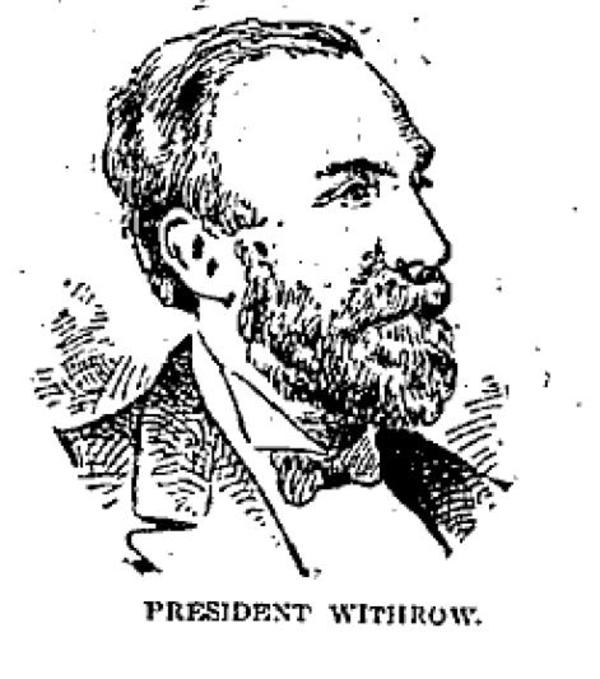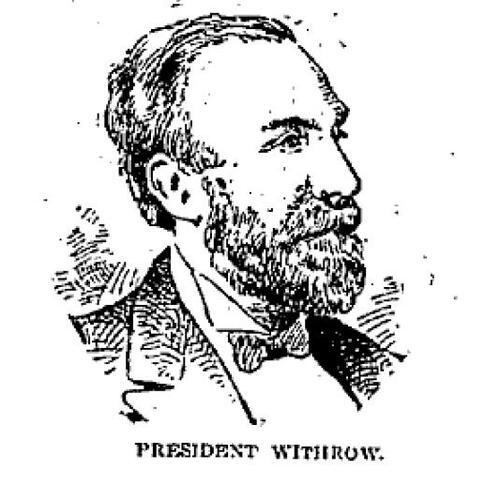
Source: Courtesy of Wikimedia Commons
WITHROW, JOHN JACOB, businessman, philanthropist, politician, and office holder; b. 1833 in York (Toronto), Upper Canada, son of James Withrow and Ellen Sanderson; m. Margaret Foster, and they had three sons and two daughters; d. 5 Aug. 1900 in Toronto.
The Withrow family came originally from Virginia and settled in what is now Canada in the aftermath of the American revolution. John Jacob Withrow was educated at the Toronto Academy. He then worked in an architect’s office for a time and got his practical training as a contractor in his father’s building firm, McBean and Withrow. He finished his training with a tour of the northern United States, observing design trends and building methods. Some time in the late 1850s he left home and began working as a carpenter in Toronto. In 1865 he formed Withrow and Hillock, building contractors and lumber merchants, with John Hillock as his partner. The firm specialized in the manufacture of wooden sashes and doors.
In 1873 Withrow turned to municipal politics. He was elected alderman for St David’s Ward that year and moved to represent St Thomas’s Ward for the next four. While on council he became fascinated by the possibilities of the annual provincial exhibition which, since its start in 1846, had been held at the major centres around the province. Toronto attracted the largest crowds, had the most exhibitors, and was the site of the fair in 1870, 1874, and 1878. In the latter year the exhibition committee, under Withrow’s enthusiastic leadership, enlarged the grounds and increased the number of permanent buildings in the happy expectation that the fair would remain at Toronto for some time. The Provincial Fair Association thought otherwise and voted to take the 1879 fair to Ottawa. At the closing banquet of the 1878 fair, Withrow, apparently without consulting anyone, announced that there would be a permanent exhibition in Toronto the next year. His colleagues on council thought him rash. However, Withrow, with wide support, formed the Industrial Exhibition Association of Toronto. Its fair, the predecessor of the Canadian National Exhibition, opened to instant success in the fall of 1879 and he remained president of the association until shortly before his death.
The early 1880s saw the completion of the Canadian Pacific Railway and, as a consequence, the opening of the northwest to settlers. To achieve an orderly settlement of these new lands, government policy encouraged the creation of colonization companies which would develop whole communities. In early 1882, Withrow with Alexander Sutherland*, who was the general secretary for missions of the Methodist Church of Canada, and a group of prominent Methodist businessmen like himself formed the Saskatchewan Land and Homestead Company Limited to promote western colonization. It was a considerable success. The company survived the catastrophic decline in western land prices of 1883–84 and a radical change in Canadian settlement policy in 1887. It was still in business at the end of the century. Withrow was the founding president and retained that position to the end of his life.
Still flush from his success in establishing the Toronto exhibition and concerned for the success of the temperance movement, Withrow ran for mayor of Toronto in 1883. He lost by five votes to Arthur Radcliffe Boswell. A dispute with the trade union movement relating to his own conduct as an employer and his intervention in the printers’ strike of 1872 probably cost him the election. In 1885 there was some feeling that Withrow, one of the senior reformers in civic politics, deserved an uncontested election as mayor. The tory element thought differently and brought Alexander Henderson Manning*, a former mayor, out of retirement to defeat Withrow again.
As a builder and successful organizer, and as a respected member of Metropolitan Church, Withrow was able to assist with a number of cultural and charitable building projects in Toronto during the 1880s and 1890s. He worked with John Ross Robertson* on the Hospital for Sick Children’s summer home as well as on the reconstruction of the hospital itself. Robertson had decided that the patients needed a summer retreat, and he bought land at Hanlans Point on Toronto Island. Here in 1883 Withrow built a residence, the Lakeside Home for Little Children, of which he was a trustee. When a new Hospital for Sick Children was constructed in the late 1880s, Withrow appears to have been one of the fund-raisers, and he is reputed to have supervised the construction.
Hart Almerrin Massey, a staunch Methodist and fellow member of Metropolitan Church, decided in the 1880s to give Toronto a concert hall. The design and construction of Massey Music Hall took better than ten years. Withrow and Hillock did the carpentry work and supplied the doors and sashes. The hall was operated by a board of trustees with Withrow as chairman, and during his lifetime he was the only non-Massey trustee.
Withrow remained an active builder throughout most of his life. With Hillock he developed Wilton Crescent, a fashionable neighbourhood at what is now the corner of Sherbourne and Dundas streets in Toronto. Here the pair built themselves large houses. Withrow and Hillock were also engaged in the development of Toronto’s east end. In 1886, in company with John Macdonald*, a highly successful wholesaler, they opened a subdivision centred on Withrow Avenue. Withrow was also the president of the Canadian Mutual Loan and Investment Company, a second-rank savings and loan society. The Canadian Mutual was so aggressively marketed that the business morality, if not the strict legality, of its operations was questioned in the press by disillusioned shareholders. The Ontario Loan Corporations Act of 1897 and the subsequent acts of the early 1900s, which regulated the operation of loan companies in Ontario, appear to be in response to complaints received about Canadian Mutual and similar companies. From the point of view of the officers and directors, however, the Canadian Mutual was exceedingly profitable.
Whatever Withrow’s success in real estate development it did not last through the depression of the 1890s. In the fall of 1894 Withrow and Hillock declared bankruptcy, being unable to realize on its substantial investment in property. When Withrow died he did not even own his house and his estate was modest. Perhaps his appointment as chief assessor for Toronto in 1895 had been a practical way to reward a lifetime of service. The Daily Mail and Empire said of him: “He was possessed of clear judgement, good executive ability, and ripe business knowledge. He was a man of wide charity and unfailing courtesy, and was noted for his probity and industry.” His death from a stroke was sudden and unexpected.
[In addition to the sources cited below, this biography is based on the author’s interview with John Withrow of Toronto, a grandson of the subject. p.c.]
AO, MU 1961, no.29. York County Surrogate Court (Toronto), no.14244 (mfm. at AO). Daily Mail and Empire (Toronto), 7 Aug. 1900. Globe, 7 Aug. 1900. “Born out of protest,” Once upon a century: 100 year history of the ‘EX’ (Toronto, 1978), 8–21. Max Braithwaite, Sick Kids: the story of the Hospital for Sick Children in Toronto (Toronto, 1974). William Dendy, Toronto observed: its architecture, patrons, and history (Toronto, 1986).
Cite This Article
Philip Creighton, “WITHROW, JOHN JACOB,” in Dictionary of Canadian Biography, vol. 12, University of Toronto/Université Laval, 2003–, accessed January 7, 2026, https://www.biographi.ca/en/bio/withrow_john_jacob_12E.html.
The citation above shows the format for footnotes and endnotes according to the Chicago manual of style (16th edition). Information to be used in other citation formats:
| Permalink: | https://www.biographi.ca/en/bio/withrow_john_jacob_12E.html |
| Author of Article: | Philip Creighton |
| Title of Article: | WITHROW, JOHN JACOB |
| Publication Name: | Dictionary of Canadian Biography, vol. 12 |
| Publisher: | University of Toronto/Université Laval |
| Year of publication: | 1990 |
| Year of revision: | 1990 |
| Access Date: | January 7, 2026 |



